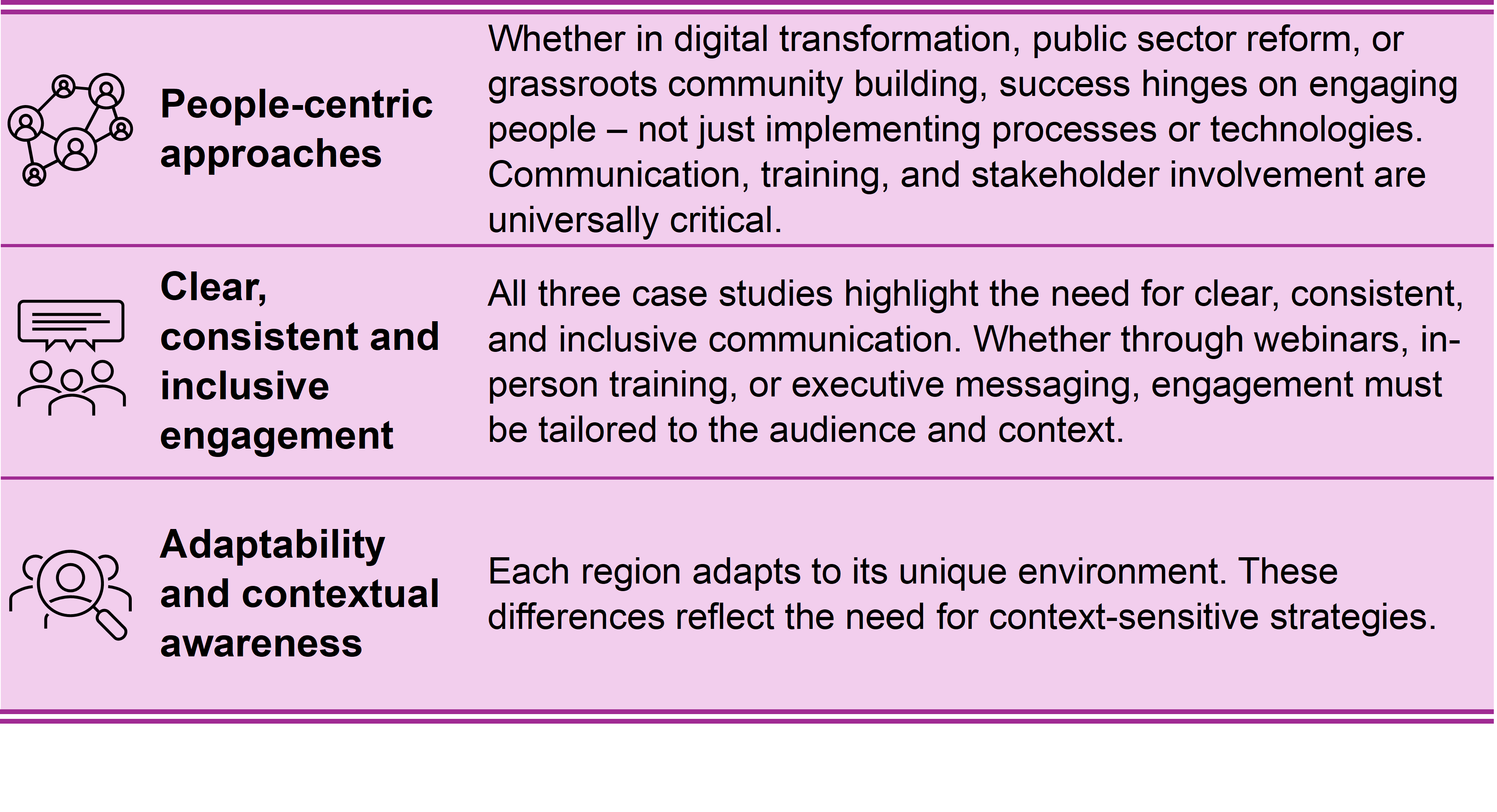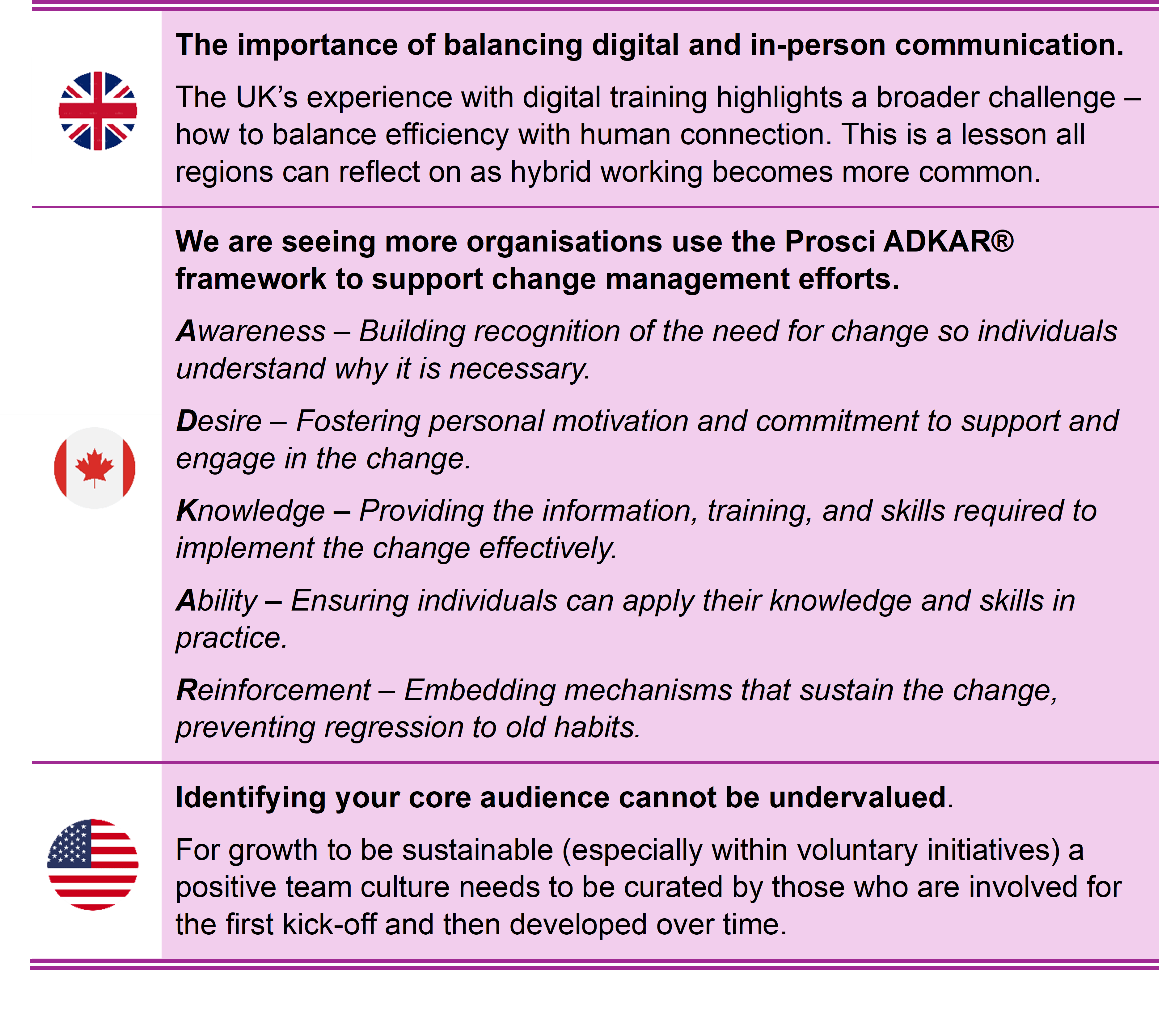Insights from the IAM Global NxtGen Representatives on Managing Change in Asset Management
30 Oct 2025
Insights from the IAM Global NxtGen Representatives on Managing Change in Asset Management
As asset management continues to evolve globally, organisations are increasingly facing complex change. This article brings together three different perspectives on how change is being approached across regions and sectors, through the lens of IAM NxtGen Representatives. The IAM NxtGen is a global group of new asset managers (within the first five years of their asset management career), focused on engagement and involving new professionals in asset management career development and professional engagement.
The article explores change management in the private sector, public sector, and non-profit. It draws insights that span all three areas, highlighting where approaches align and where they differ.
The role of Technology in Effective Change Management across the UK
Asset management has entered the age of digital transformation. This shift is not only about adopting new technologies, but it is about reshaping how people work, communicate, and make decisions. Effective change management is essential to guide people through these transformations and ensure long term success. For digital transformations to succeed, it is essential to manage the people within the programmes. 

Organisations invest millions of pounds in digital change initiatives, but without good change management, the value of the programmes is not fully realised. Without clear communication, training, and strong engagement, organisations will not fully realise the intended benefits of such initiatives. This applies to all asset-intensive industries such as rail, water, utilities, transport, and energy, as in these industries reliable and safe operations depend on frontline staff, engineers, and back-office teams working in sync. It is therefore essential that training should be inclusive, and break down silos between all stakeholders, not just technical staff.
The importance of in-person interactions is not limited to digital transformations but is especially important when training and behavioural change is involved. In the UK private sector, managing change effectively often hinges on how we communicate. It is easy to assume that most professionals are comfortable with digital tools, but this is not always the case. Data collected and analysed by Statista from 2024 identified that 12% of the UK population are not internet users[1] – a reminder that digital literacy cannot be taken for granted. This has real implications for how we design and deliver change programmes. Highlighting the importance of inclusive training methods that accommodate varying levels of digital literacy.
During a recent project, training a safety inspection team to apply a risk-based approach to hazard categorisation, the value of face-to-face communication was evident. In-person sessions not only encouraged more engagement and meaningful interaction, but also improved the team’s performance (hazard categorisation consistency). The first round of assessments was conducted online via Microsoft Teams, using a digital exam format, resulting in noticeable gaps in understanding and performance. In contrast, the second round was held in person, using a traditional pen-and-paper exam. The improvement in results was significant – not just in scores, but in the confidence and clarity demonstrated by participants.
Since COVID-19, face-to-face interactions have declined, and while remote interactions offer flexibility, they also present challenges. Stakeholder engagement and the adoption of change are harder to achieve in virtual environments. As demonstrated by the safety inspectors a balance between digital efficiency and human connection needs to be met, to ensure the value of change is realised.
Driving Change Management Success in the Canadian Public Sector
Change management in public sector organisations is inherently complex, requiring deliberate leadership, structured processes, and cultural alignment to succeed. Recent roundtable discussions with senior leaders from multiple public sector organisations emphasised that effective sponsorship is the cornerstone of transformational change. Sponsors must be carefully selected based on leadership capability and their dedication to championing the initiative. One size does not fit all, and sponsorship strategies must be tailored to the project’s complexity and organisational context. 
Training programs for executive sponsors are vital to equip them with skills to rally senior management support, navigate roadblocks, and engage stakeholders effectively. However, sponsors and change agents often juggle multiple projects with interdependencies, which underscores the need for enhanced project visibility, effective resource allocation, and portfolio coordination.
Establishing a centralised Change Management Office (similar to a Project Management Office but focused on change initiatives) can provide governance, reduce organisational change fatigue, and sustain momentum by coordinating changes across departments. Equally important is fostering a culture that embraces change. Culture is fluid and driven by daily behaviours, interactions, and shared values. True cultural change is evident when staff act in alignment with desired norms even when unobserved.
Transparent and consistent communication is critical to build trust and maintain stakeholder engagement throughout the change process. Public sector leaders must clearly articulate the value proposition, ensuring benefits are meaningful and relatable to both executives and front-line staff. They should also revalidate business cases at key milestones to keep projects aligned with evolving strategies.
Finally, addressing resource and skill shortages through benchmarking against similar organisations helps build a strong case for additional support. In summary, public sector change management success relies on strong sponsorship, strategic coordination, clear communication, cultural alignment, and resource readiness to deliver meaningful, sustainable outcomes for communities.
Lessons Learned from the Growing USA NxtGen Committee
Change management is not just vital to the successful delivery of projects but also support the growth of small (but equally important) initiatives such as the IAM NxtGen USA chapter. The IAM NxtGen USA chapter committee was created to bring together emerging AM professionals and those new to the asset management field. As we’ve grown and evolved, one of our biggest lessons has been the importance of applying change management principles to drive engagement and build a strong foundation for the group.
Our priority was identifying our core audience – specifically, members across the USA who aligned with IAM NxtGen’s mission and values. This required targeted outreach. With the support of my committee chair, we put significant effort into reaching potential members, including distributing interest forms via email and hosting webinars to raise awareness and build interest. These sessions were not only informative but also helped create a sense of community early on.
Through this strategic approach, we successfully grew our committee from just two members to a seven-person team, now including an additional Canadian liaison to strengthen cross-border collaboration. This growth reflects not only increased interest in asset management among emerging professionals but also the effectiveness of our communication and engagement efforts.
Key change management takeaways include the value of clear role definitions, consistent messaging, and creating space for feedback. We’ve also learned the importance of meeting our members where they are – leveraging digital tools, virtual platforms, and peer-to-peer outreach to foster inclusion and accessibility.
As we continue to evolve, the IAM NxtGen USA Chapter group will keep applying these change management practices to remain responsive, inclusive, and sustainable to ensure the next generation of asset managers is well-supported and empowered to lead.
NxtGen’s Global Lessons in Change Management
1. Common Themes from across the UK, Canada and the USA

2. Opportunities for Shared Learning

3. Why Change Management Matters to the IAM NxtGen
As representatives of the Global NxtGen Committee, we recognise that change management is not merely a support function, but a strategic enabler of effective and sustainable improvement. Across our case studies, spanning three countries and diverse project types, we consistently observed the importance of tailoring change management strategies to suit both the project context and stakeholder needs. We place strong value on in-person engagement, structured planning, and feedback loops – elements that foster open dialogue, strengthen stakeholder relationships, and empower early-career professionals to contribute meaningfully. These shared principles highlight the universal relevance of change management, while also underscoring the need for context-sensitive approaches that reflect local cultures, organisational structures, and community expectations.
[1] Statista. (2025, June 13). Internet usage in the United Kingdom (UK) - statistics & facts. https://www.statista.com/topics/3246/internet-usage-in-the-uk/
